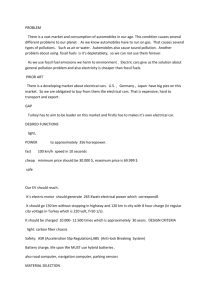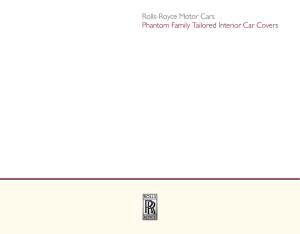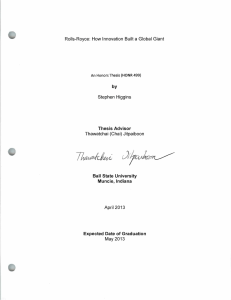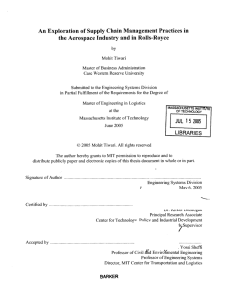Here
advertisement
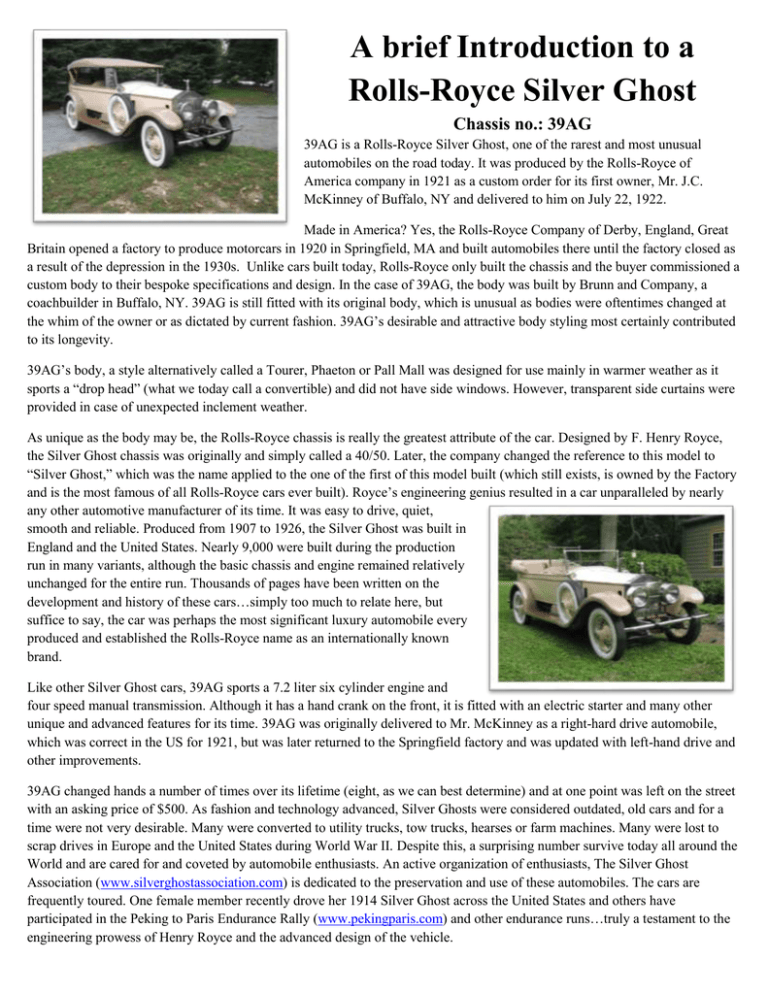
A brief Introduction to a Rolls-Royce Silver Ghost Chassis no.: 39AG 39AG is a Rolls-Royce Silver Ghost, one of the rarest and most unusual automobiles on the road today. It was produced by the Rolls-Royce of America company in 1921 as a custom order for its first owner, Mr. J.C. McKinney of Buffalo, NY and delivered to him on July 22, 1922. Made in America? Yes, the Rolls-Royce Company of Derby, England, Great Britain opened a factory to produce motorcars in 1920 in Springfield, MA and built automobiles there until the factory closed as a result of the depression in the 1930s. Unlike cars built today, Rolls-Royce only built the chassis and the buyer commissioned a custom body to their bespoke specifications and design. In the case of 39AG, the body was built by Brunn and Company, a coachbuilder in Buffalo, NY. 39AG is still fitted with its original body, which is unusual as bodies were oftentimes changed at the whim of the owner or as dictated by current fashion. 39AG’s desirable and attractive body styling most certainly contributed to its longevity. 39AG’s body, a style alternatively called a Tourer, Phaeton or Pall Mall was designed for use mainly in warmer weather as it sports a “drop head” (what we today call a convertible) and did not have side windows. However, transparent side curtains were provided in case of unexpected inclement weather. As unique as the body may be, the Rolls-Royce chassis is really the greatest attribute of the car. Designed by F. Henry Royce, the Silver Ghost chassis was originally and simply called a 40/50. Later, the company changed the reference to this model to “Silver Ghost,” which was the name applied to the one of the first of this model built (which still exists, is owned by the Factory and is the most famous of all Rolls-Royce cars ever built). Royce’s engineering genius resulted in a car unparalleled by nearly any other automotive manufacturer of its time. It was easy to drive, quiet, smooth and reliable. Produced from 1907 to 1926, the Silver Ghost was built in England and the United States. Nearly 9,000 were built during the production run in many variants, although the basic chassis and engine remained relatively unchanged for the entire run. Thousands of pages have been written on the development and history of these cars…simply too much to relate here, but suffice to say, the car was perhaps the most significant luxury automobile every produced and established the Rolls-Royce name as an internationally known brand. Like other Silver Ghost cars, 39AG sports a 7.2 liter six cylinder engine and four speed manual transmission. Although it has a hand crank on the front, it is fitted with an electric starter and many other unique and advanced features for its time. 39AG was originally delivered to Mr. McKinney as a right-hard drive automobile, which was correct in the US for 1921, but was later returned to the Springfield factory and was updated with left-hand drive and other improvements. 39AG changed hands a number of times over its lifetime (eight, as we can best determine) and at one point was left on the street with an asking price of $500. As fashion and technology advanced, Silver Ghosts were considered outdated, old cars and for a time were not very desirable. Many were converted to utility trucks, tow trucks, hearses or farm machines. Many were lost to scrap drives in Europe and the United States during World War II. Despite this, a surprising number survive today all around the World and are cared for and coveted by automobile enthusiasts. An active organization of enthusiasts, The Silver Ghost Association (www.silverghostassociation.com) is dedicated to the preservation and use of these automobiles. The cars are frequently toured. One female member recently drove her 1914 Silver Ghost across the United States and others have participated in the Peking to Paris Endurance Rally (www.pekingparis.com) and other endurance runs…truly a testament to the engineering prowess of Henry Royce and the advanced design of the vehicle. A Few Words About the Company The Rolls-Royce Company was formed as a partnership of Henry Royce, a self-taught engineer and Charles Rolls, an early automobilist and marketer of automobiles in 1905 in England. Rolls was looking for a reliable automobile to market and through the intervention of a common friend was introduced to Royce. The original factory was in Manchester with later production in Derby, Crewe and for a time in Springfield, MA, USA. Although the Company is best known for manufacturing automobiles, the Company’s primary lines were in other engines, mainly aircraft engines. Many commercial and military aircraft today are powered by Rolls-Royce engines. Look at the engine on your aircraft next time you fly to see if it is Rolls-Royce powered! In 1971, the motor car division was spun off as a separate, British-owned entity. More recently, the Rolls-Royce automobile brand was acquired by BMW and cars today are produced by BMW under licensure of the name. Other very active organizations dedicated to all models of RR cars include the Rolls-Royce Owners’ Club (www.rroc.org) in the United States and Canada and the Rolls-Royce Enthusiasts’ Club (www.rrec.co.uk) in Great Britain and Europe. Other enthusiast groups exist elsewhere as the cars were sold worldwide. The Australian Owners’ Club is very active, for example. Much information (and misinformation!) exists on the internet and in books about Rolls-Royce cars and we encourage you to learn more, particularly of the engineering genius of Henry Royce. For a car like 39AG to have lasted for nearly 90 years and be fully roadworthy and capable of operation on modern roads and in modern traffic conditions is truly a testament to its design. Common Questions and Myths Answered We are often asked many questions about the car and are happy to share the car and what we know with interested individuals. Here are the most popular ones: Q. Is it true that the car is guaranteed for life and if it fails to proceed (Rolls-Royce cars never “break down”), the Company sends out another car and/or picks you up in a helicopter? A. Unfortunate for us, this is not true. We are very much hands-on owners and do many of the repairs and maintenance ourselves. This myth developed when the Company at one point briefly considered an unlimited warranty, but instead offered a still groundbreaking three year warranty. The helicopter myth perhaps comes from when the Company sent out field representatives to check the early cars for proper running and address any concerns the owner may have had. Q. Is it true that the bonnet is locked and you cannot see or service the engine? A. Again, not true. The engine is readily serviceable by the owner. We’ve had oil-stained hands many times maintaining 39AG! This myth probably developed from the Company’s use of small wire seals to lock down adjustments on the carburetor. Once set, the factory advised they not be changed…and there was usually no need to. Q. What is it worth? A. Not easy to say. Some early Silver Ghosts have sold for nearly $2 Million Dollars at collector auctions, while others have sold for under $100,000 but needing a full restoration after having sat unused for many years. Perhaps the best answer is that the car is worth what a collector or enthusiast is willing to pay for it. Q. How Many Miles Per Gallon Does It Get? A. A surprising amount, considering its age and the size of its engine. In highway driving, 39AG can get anywhere from 12 to 16 MPG. Certain other lighter Ghosts are known to get 20MPG while cars with heavier bodies can get less. Considering that most modern cars today with much smaller engines do not do that much better, you would have thought we would have learned more about fuel economy in the past 90 years. Q. Where do you get the tires? A. Surprisingly, tires are readily available from a number of sources. 39AG sports 7.00x21 low pressure, bias-ply tires and there is a tube in each one. Q. Is it true that Rolls-Royce changed the color of the badge on the radiator from red to black upon Royce’s death in 1931? A. No, it is not true. It was changed to black in order to better compliment the many different body variations and colors fitted to the cars by the Coachbuilders. A Friendly Reminder…Classic Car Courtesies We appreciate your enthusiasm and interest in our automobile and we enjoy sharing our car with interested persons. However, we ask that you do not touch or stand on the car as is common courtesy to classic car owners and common practice worldwide.



